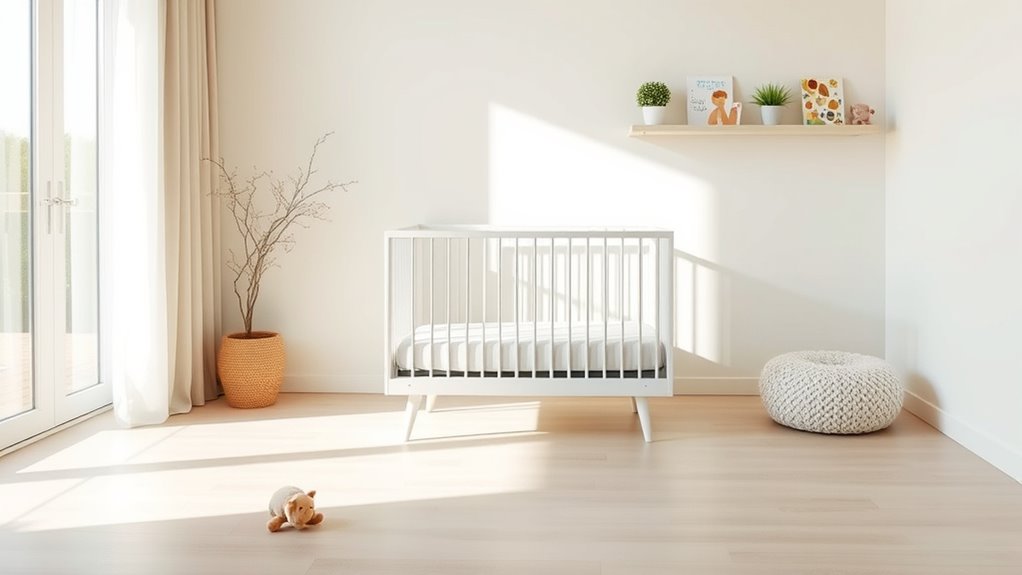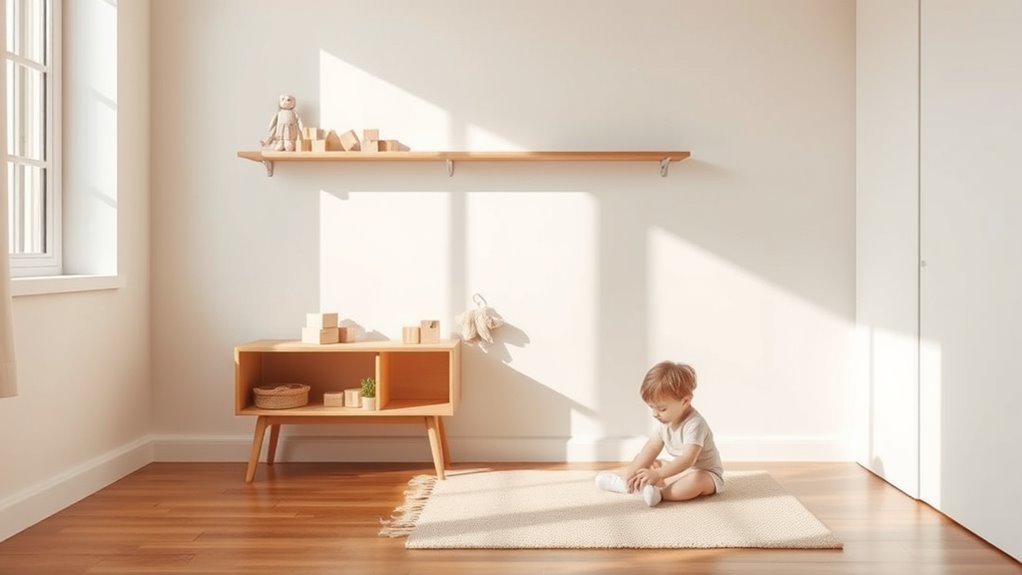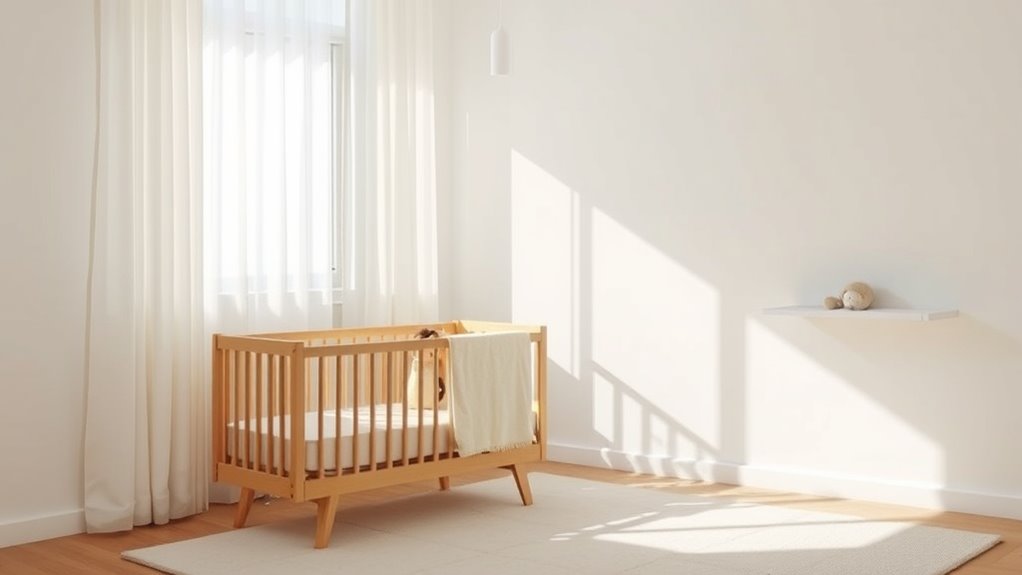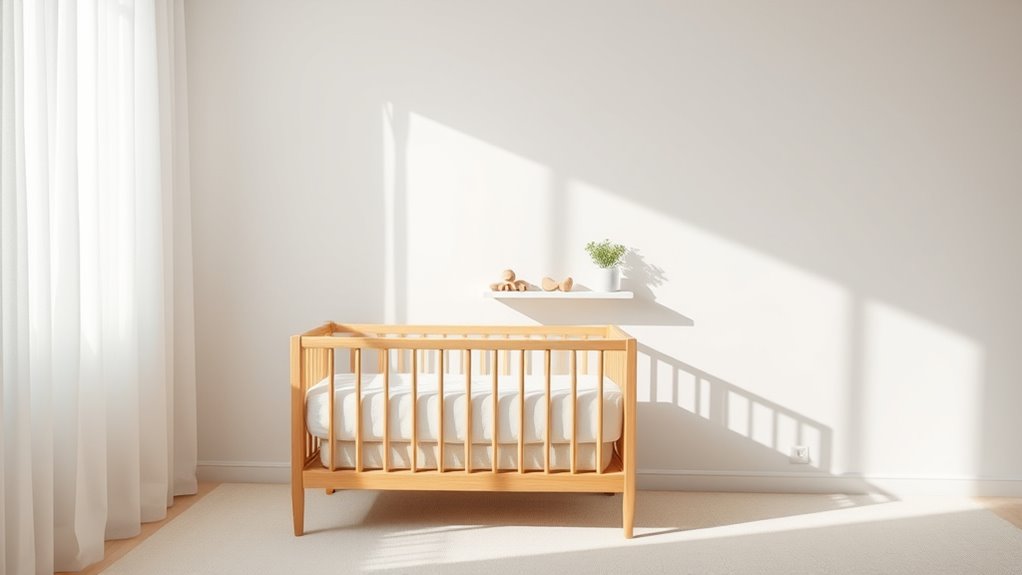To raise kids without clutter, focus on simplifying their environment by reducing toys, screens, and overstimulating decor. Prioritize quality over quantity in toys and activities, choosing durable and open-ended options that promote creativity. Set clear boundaries for screen time and commitments, establishing routines to bring structure. Cultivate mindful parenting by practicing active listening and staying present. Creating a calm, organized home supports focus and emotional well-being—keep exploring for practical tips to start your minimalist journey.
Key Takeaways
- Limit toys and possessions to high-quality, open-ended options that encourage creativity and reduce clutter.
- Establish consistent routines for tidying up and organizing to maintain a calm, orderly environment.
- Minimize screen time and unnecessary activities to focus on meaningful interactions and free play.
- Use calming decor and natural lighting to create a peaceful, clutter-free home atmosphere.
- Practice mindful parenting by listening actively, validating feelings, and fostering emotional connection.
Simplifying Your Child’s Environment for Better Focus

Creating a simpler environment can considerably boost your child’s ability to focus. Start with digital decluttering by removing unnecessary apps, notifications, and screens to reduce distractions. Limiting screen time helps your child develop better attention spans and encourages more meaningful play. Emphasize sensory simplicity by choosing toys, furniture, and decor that are calm, neutral, and free of overstimulating patterns or colors. A clutter-free space minimizes visual chaos, allowing your child to concentrate on one task at a time. Keep surfaces clear and organize belongings into designated spots. This intentional setup creates a peaceful atmosphere that promotes focus and calmness. Additionally, incorporating Halloween decorations that are simple and subdued can prevent overstimulation and maintain a relaxing environment. By reducing digital clutter and embracing sensory simplicity, you help your child develop the skills to concentrate and engage with their environment more effectively.
Choosing Quality Over Quantity in Toys and Activities

Instead of overwhelming your child with numerous toys and activities, focus on selecting high-quality options that foster deeper engagement and development. Thoughtful toy selection means choosing items that are durable, open-ended, and encourage creativity. Instead of buying many cheap toys, opt for a few well-made ones that can be used in multiple ways. Incorporating sustainable materials into your choices not only benefits the environment but also teaches children about environmental responsibility. When it comes to activities, practice moderation; avoid over-scheduling and allow your child time to explore and play freely. High refresh rates in toys and activities can also promote better focus and responsiveness. Choosing quality toys that are safe and well-designed can significantly enhance your child’s learning experience. Additionally, selecting toys that promote developmental benefits ensures that playtime supports their overall growth. Quality toys and balanced activities help your child develop better problem-solving skills, imagination, and focus. Remember, less truly can be more—prioritizing meaningful experiences over quantity creates a calmer, more intentional environment that supports your child’s growth.
Setting Boundaries to Reduce Overcommitment

When you set clear boundaries around your child’s commitments, you help prevent over-scheduling and reduce stress. Limiting screen time is a simple yet effective way to create space for more meaningful activities and downtime. Establish routines that prioritize regular mealtimes, homework, and bedtime, which provide a predictable structure and help your child feel secure. Saying no to extra activities or commitments that don’t align with your family’s values allows you to maintain a manageable schedule. Communicate these boundaries openly, so your child understands why limits are necessary. Consistency is key; when boundaries are clear and firm, your child learns to manage their own time and reduces the likelihood of feeling overwhelmed. Incorporating setting boundaries into your routine fosters a calmer, more focused family environment.
Cultivating Mindful Parenting Practices

Cultivating mindful parenting practices involves being fully present with your child and approaching interactions with intention and awareness. When you practice mindful communication, you listen actively and respond thoughtfully, fostering trust and connection. Emotional awareness is key—you recognize and validate your child’s feelings without judgment, helping them develop their own emotional intelligence. You can also incorporate mindfulness techniques into daily routines to create a more calm and centered household. By staying grounded in the moment, you reduce reactive responses and create a calm, supportive environment. Incorporating investment strategies can further support this mindful approach by helping parents plan for future financial security, reducing stress about resources. Understanding cookie categories and managing user consent effectively can also foster a respectful and transparent online environment for your family. This approach encourages your child to feel heard and understood, strengthening your bond. Incorporating mindfulness into everyday interactions doesn’t require perfection; it’s about consistently bringing awareness to your responses and being intentional with your time and attention. Using the right parenting tools and techniques can further support this mindful approach. Over time, these practices cultivate a more peaceful, connected relationship rooted in presence and understanding.
Creating a Calm and Organized Home Space

Creating a calm and organized home space starts with intentionally designing your environment to promote tranquility and order. A clutter-free environment reduces stress, enabling better parental communication and fostering emotional resilience in your children. Focus on simplifying routines and minimizing excess possessions to create a sense of peace. Consider implementing these strategies:
- Designate specific storage areas for toys and supplies
- Use calming colors and natural lighting
- Keep surfaces clear and clutter-free
- Establish consistent routines for tidying up
- Limit the number of possessions to avoid overwhelm
- Incorporate home organization techniques inspired by Italian espresso cafes to enhance simplicity and elegance throughout your space. Additionally, incorporating mindfulness practices can help maintain a peaceful atmosphere and encourage present-moment awareness in daily routines. Drawing inspiration from Water Parks, creating designated zones for different activities can also help children understand boundaries and develop routines that promote calmness and order. Utilizing vacuum technology to maintain cleanliness can further contribute to a serene environment by reducing allergens and dust.
Frequently Asked Questions
How Can Minimalist Parenting Improve a Child’s Emotional Development?
You can help improve your child’s emotional development by fostering emotional resilience and self-awareness. When you simplify their environment, they experience less overwhelm, allowing them to better understand and manage their feelings. Encouraging open conversations and modeling healthy coping skills build their confidence and self-awareness. As a result, your child learns to navigate emotions more effectively, becoming more resilient and emotionally balanced over time.
What Are Effective Ways to Handle Relatives’ Gift-Giving Habits?
Think of gift-giving as a garden; you set boundaries to prevent it from becoming overgrown. Clearly communicate your wishes to relatives, expressing gratitude for their kindness while gently guiding their choices. Let them know what your family values and how you prefer to handle gifts. By setting boundaries and expressing gratitude, you nurture healthy relationships and keep the gift-giving from turning into a wild jungle of clutter.
How Does Minimalism Impact a Child’s Creativity and Imagination?
You might wonder how minimalism affects your child’s creativity and imagination. When you prioritize quality over quantity, you give your child more creative freedom with fewer, more meaningful toys. This encourages imaginative play, as they learn to invent stories and explore ideas without distraction. By limiting clutter, you help your child develop deeper focus and resourcefulness, fostering their ability to think creatively and imagine freely.
What Challenges Might Parents Face When Adopting Minimalism?
You might face challenges like parental resistance, especially if you’re used to buying lots of toys and supplies. Society’s expectations can pressure you to conform, making it hard to stick with minimalism. You’ll need to navigate these influences and stay committed to your values. It can be tough, but focusing on quality over quantity and emphasizing experiences helps you overcome these hurdles and create a simpler, more intentional environment for your kids.
How Can Minimalist Principles Be Adapted for Different Ages?
You adapt minimalist principles by embracing age-appropriate activities that foster independence and curiosity, rather than overwhelming your kids with excess. Use decluttering strategies tailored to each stage—simplify toys for toddlers, reduce school supplies for older children. By adjusting your approach, you create a calm environment that nurtures growth while avoiding clutter, making minimalism a natural part of your family life at every age.
Conclusion
By simplifying your child’s environment and focusing on quality over quantity, you create space for meaningful growth. Setting boundaries helps prevent overcommitment, while mindful parenting fosters stronger connections. An organized, calm home supports your child’s development and well-being. Isn’t it worth asking if less clutter and more intentional choices could lead to happier, more focused kids? Embrace minimalism and watch your family thrive with less chaos and more clarity.









